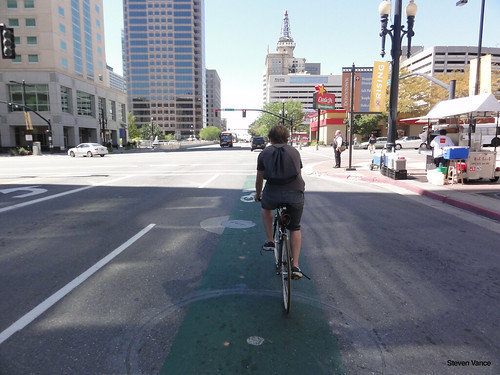A 2005 study by Barnes, Thompson, and Krizek examined how the addition of bicycling facilities during the 1990s influenced localized bicycle commuting rates in the Twin Cities. They found that new facilities had a small but consistent and statistically significant impact on increased rates of bicycle commuting in areas immediately surrounding these facilities. This study expands on these findings by applying the same methodology to six other cities that experienced new facility construction during the 1990s: Austin, TX, Chicago, IL, Colorado Springs, CO, Salt Lake City, UT, Madison WI, and Orlando, FL. The purpose is to determine whether results from the Twin Cities are consistent elsewhere and to identify possible contextual factors influencing facilities’ impact on bicycle commuting rates in a given city.
We conclude that the “build it and they will come” theory is not universally applicable; context factors are an important element in determining the effectiveness of new commuting facilities. Specifically, we identify three key themes that were present in cities whose bicycling commute mode share increased around new bicycling facilities. The first theme is location of facilities along usable commuting routes, best illustrated by the city of Chicago. Bicycling facilities lead from distant parts of the city and converge in the downtown employment hub. In Austin, facilities are also oriented toward the central city and connect the city’s densely-settled residential neighborhoods with this location. In contrast, the new bicycling facilities in Orlando do not converge on any central location. A message that can be drawn from this comparison is that bicycling facilities are most effective in highly-accessible urban areas where a large number of commute trips can take place across short distances. In locations where bicycling facilities could provide viable commuting routes between residential and employment concentrations, increases in bicycle commuting rates were likely to occur.
The second key theme is overall network connectivity. In both Austin and Madison, the network of bicycling facilities covers a large part of the central city. Numerous intersections among these trails allow a bicyclist to easily navigate from one section of the city to another. The connectivity of Austin’s facility network contrasts with the single trail constructed during the 1990s in Colorado Springs. In Austin, a potential bike commuter could reside in a variety of locations and still ride to an employment location in most parts of the central city. In Colorado Springs, a bicycle commuter would have to both live and work along the length of the Pikes Peak Greenway Trail for this to be a viable new commuting option.
The final key theme is the amount of publicity and promotion dedicated to new bicycling facilities. The contrast between the change in commute rates in Chicago and Salt Lake City best illustrates this idea. In Chicago, new bicycling facilities were added in combination with a multitude of other efforts by city planners and advocates to advertise their presence and promote bicycle commuting among city residents. This combination of efforts was simply not present in a similar magnitude in Salt Lake City during the 1990s. A bicycling facility can only be adopted by commuters if they are aware of its existence and excited to adopt bicycles as their commute mode.
The second key theme is overall network connectivity. In both Austin and Madison, the network of bicycling facilities covers a large part of the central city. Numerous intersections among these trails allow a bicyclist to easily navigate from one section of the city to another. The connectivity of Austin’s facility network contrasts with the single trail constructed during the 1990s in Colorado Springs. In Austin, a potential bike commuter could reside in a variety of locations and still ride to an employment location in most parts of the central city. In Colorado Springs, a bicycle commuter would have to both live and work along the length of the Pikes Peak Greenway Trail for this to be a viable new commuting option.
The final key theme is the amount of publicity and promotion dedicated to new bicycling facilities. The contrast between the change in commute rates in Chicago and Salt Lake City best illustrates this idea. In Chicago, new bicycling facilities were added in combination with a multitude of other efforts by city planners and advocates to advertise their presence and promote bicycle commuting among city residents. This combination of efforts was simply not present in a similar magnitude in Salt Lake City during the 1990s. A bicycling facility can only be adopted by commuters if they are aware of its existence and excited to adopt bicycles as their commute mode.
 |
| Cycling in Salt Lake City |
Our findings raise several questions for further study. One of the most obvious questions is how bicycle commute mode will change around facilities constructed between 2000 and 2010. Many of the bicycling coordinators we interviewed felt that the popularity of bicycling in their communities reached new levels after the year 2000, and pointed out numerous network expansions since that time. Increasing the study’s time span would help uncover trends in commuting rather than snapshots at two particular points in time.
Secondly, although this study did not find off-street facilities to be more beneficial to commuters than on-street trails, these facilities have value as non-work travel routes, recreation destinations, and public amenities. A survey of users’ travel purposes is underway in Minnesota; these findings will enhance our understanding of off-street facilities and provide important groundwork for future studies on the subject of travel behavior and the usefulness of bicycling for non-work travel trips.
Lastly, this study identifies several qualitative factors that contribute to the success of city bicycle facilities. A methodology that quantitatively identifies and measures qualitative indicators could provide useful insight and guidance as to how city policy-makers could best address bicycle commuting in their city.
more about bicycle planning:
No comments:
Post a Comment